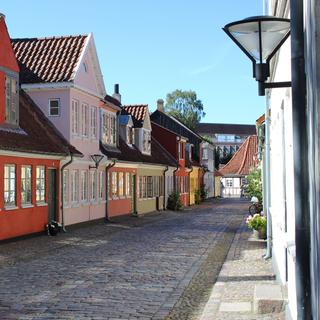Esbjerg weather and climate in 2026
Day
4 °C
Night
-1 °C
Sea
3 °C
Precipitation
48 mm
in month
Rainy days
9 days
in month
Daylight
10 hours
average
Sunshine
2 hours
average
Humidity
89 %
Weather charts for Esbjerg
Find more destinations like this
Closest destinations for Esbjerg
Closest cities for Esbjerg
Weather overview for Esbjerg
Weather overview
Esbjerg, Denmark, characterized by a temperate oceanic climate, sees the mercury column climbing from a cool 4 °C (39 °F) in January to a pleasant 20 °C (69 °F) in August. Daytime temperatures fluctuate throughout the year, accompanied by moderate precipitation levels and changing wind speeds. Visitors should prepare for a reliably moist atmosphere, with humidity levels typically hovering above 80 %. The city experiences the maximum daylight hours during the bright summer months, making outdoor activities more enjoyable. Boasting the least rainfall in April, Esbjerg's weather is an ever-changing tapestry that requires smart layering and an appreciation for diverse climatic conditions.
January weather
January in Esbjerg sees the coldest daytime temperatures of the year at a chilly 4 °C (39 °F), with nights dipping slightly lower, averaging 0 °C (31 °F). The month comes with a significant number of rainy days, approximately 13 days, so be sure to pack a reliable waterproof jacket. With the sun making a brief appearance for just over an hour per day, winter outdoor activities are subdued by gray skies.
February weather
In February, Esbjerg offers marginally warmer days than January, with temperatures peaking at 4 °C (39 °F). Nighttimes remain cold with an average low of -1 °C (31 °F). Wind speeds remain brisk, at 7, adding to the sensation of cold. However, with fewer rainy days at about 10 days compared to January, the odds slightly improve for dry spells.
March weather
As spring approaches in March, Esbjerg sees a slight temperature rise with daytime highs averaging 6 °C (43 °F). The nighttime chill lingers, though, with lows around 1 °C (34 °F). Persistent cloudy skies yield around 10 days of rainy conditions. With increasing daylight to 3 hours, outdoor activities slowly regain appeal.
April weather
April offers a breath of fresh air in Esbjerg as temperatures climb to an average high of 11 °C (51 °F). Nights are still cool averaging 4 °C (39 °F). The city enjoys the least amount of rainfall in April, with an average of 35 mm (1.39 in) spread across 8. Sun exposure increases significantly to over five hours per day, hinting at more inviting weather to come.
May weather
May marks the beginning of warmer days in Esbjerg, with average daytime temperatures reaching 16 °C (60 °F) and nights at a comfortable 8 °C (46 °F). Rain is still a common occurrence, spanning across 9. Sunshine hours peak at almost 7 hours per day, incentivizing outdoor exploration and the enjoyment of spring's full bloom.
June weather
June's weather in Esbjerg is characterized by rising temperatures reaching up to 18 °C (64 °F) by day, and relatively mild nights at 11 °C (52 °F). The sun now graces the city with its presence for almost seven hours a day, while rain still makes its presence known over 10, underscoring the need for a raincoat.
July weather
By July, Esbjerg embraces the summer spirit, with temperatures peaking at 20 °C (68 °F) during the day and descending to a mild 13 °C (56 °F) at night. A consistent number of rainy days, roughly 10, and higher humidity at 81 % make for a moist environment that can feel warmer than the thermometer reads.
August weather
August continues to ride the summer high in Esbjerg, maintaining an average daytime high of 20 °C (69 °F). Nighttime temperatures are the warmest of the year at 13 °C (56 °F). Though one of the warmest months, August also sees a slight uptick in precipitation with 79 mm (3.10 in) over 12. With lengthy daylight hours, soaking up the sun can be a daily joy.
September weather
As autumn approaches in September, Esbjerg sees a noticeable shift with daytime highs dropping to 17 °C (63 °F). The nights start to cool, averaging 11 °C (53 °F), as the city experiences 13 of rain and moisture levels rising. Increased wind speeds of 7 bring a sharper edge to the sea breeze.
October weather
October in Esbjerg presents a more pronounced autumnal chill with average highs of 13 °C (55 °F) and night lows around 8 °C (46 °F). The wind picks up a bit, averaging 7, and the city contends with the most rainy days of the year at 14, signifying the need for dependable rain gear.
November weather
November's gloom settles over Esbjerg as temperatures decrease to 8 °C (47 °F) during the day. The humidity hits a matching peak with 89 %, contributing to the colder feel. Nights average 4 °C (38 °F) with a slight reduction in wind speed to 6. Rain is still a companion as the city faces approximately 14 of wet weather.
December weather
The year rounds out in Esbjerg with December's average high at a brisk 5 °C (41 °F) and long nights cooling to 1 °C (33 °F). Expect regular precipitation over roughly 14, and consistent humidity at 91 %. December's diminished daylight of just over an hour suggests a quieter time for reflection and embracing the wintry charm of the city.
FAQs
How many layers should I wear in Esbjerg during January?
Multiple layers are the key to comfort in January's Esbjerg chill. A base layer, an insulating middle, and a windproof, waterproof outer layer will keep you warm in the average daytime high of 4 °C (39 °F).
Is February considerably windy in Esbjerg?
February's breeze can be quite sharp in Esbjerg with wind speeds averaging 7; bundling up is advisable to fend off the nippy gusts.
What kind of weather does Esbjerg experience in March?
March weather in Esbjerg is a mix of cold and the onset of spring, with average daytime temperatures reaching 6 °C (43 °F) and continued likelihood of rain.
How much sun can I expect in Esbjerg during April?
April in Esbjerg is relatively sunny, with an average of 5 hours of sunshine each day, making it much more cheerful compared to the winter months.
What should I pack for a trip to Esbjerg in May?
For May in Esbjerg, pack a mix of clothing suitable for warm days with averages around 16 °C (60 °F) and cooler evenings. Light layers and waterproof options are wise choices, given the still frequent rain.
What are typical daytime temperatures in Esbjerg during June?
Typical June days in Esbjerg are moderately warm with an average maximum temperature of 18 °C (64 °F), quite comfortable for various outdoor activities.
How warm do the days get in Esbjerg in July?
With days averaging 20 °C (68 °F) in July, Esbjerg's summer is pleasantly warm, perfect for enjoying the season's outdoor leisure options.
Can I expect warm weather throughout the day in Esbjerg during August?
August days in Esbjerg are consistently warm with an average high of 20 °C (69 °F), offering ample opportunity to relish the outdoors.
What is the typical weather like in Esbjerg during September?
September in Esbjerg transitions to typical autumnal weather with cooler days averaging 17 °C (63 °F) and an increase in windy and rainy days.
Is Esbjerg's weather in October good for outdoor activities?
Outdoor activities in October's Esbjerg can be a bit challenging due to cooler temperatures averaging 13 °C (55 °F) and frequent rain, so plan accordingly with appropriate clothing and water-resistant shoes.
Should I expect a lot of rain in Esbjerg in November?
Yes, November in Esbjerg tends to be quite rainy with nearly 14 of precipitation, making it advisable to have waterproofing as part of your attire.
How should I prepare for Esbjerg's weather in December?
Preparing for Esbjerg's December weather means dressing warmly for average daytime highs of 5 °C (41 °F), carrying umbrellas for frequent rain, and using moisturizers to combat high humidity.
We make the most from 40 years of historical weather data to predict the best weather conditions.
Deciding on where to go for a holiday is hard sometimes. Get inspired by the most popular destinations.
We aggregate data from combining multiple weather sources to ensure accuracy of the highest order.







